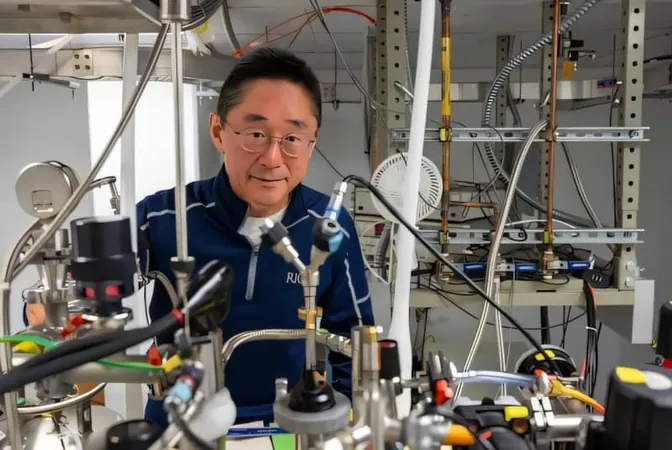
Groundbreaking Quantum Leap: A New Era for Computing and Communication
2025-04-23
Author: Ming
A Quantum Revolution on the Horizon
Quantum computing has long been heralded as the frontier of technological advancement, promising unmatched speed, accuracy, and security. However, maintaining the delicate quantum states crucial for these systems has posed a significant hurdle—until now.
Rice University Shatters Barriers with 3D Photonic-Crystal Cavity
Researchers from Rice University have made remarkable progress by developing a revolutionary 3D photonic-crystal cavity. Their recent findings, unveiled in *Nature Communications*, showcase new ways to manipulate the interplay between light and matter, opening doors to groundbreaking innovations in quantum technologies.
Revolutionizing Light Manipulation
When photons, the fundamental particles of light, interact with electrons, they create hybrid quantum states known as polaritons, enabling unprecedented control over light at microscopic scales. By constructing a complex three-dimensional optical cavity, the Rice team ventured beyond conventional 1D designs to tap into this phenomenon.
Fuyang Tay, the lead author and a postdoctoral researcher at Columbia University, likened their cavity to a room brimming with mirrors, where a beam of light bounces around endlessly. These patterns of light, termed cavity modes, facilitate significant interactions between light and matter—essential for pioneering advancements in quantum computing, precision lasers, enhanced sensors, and ultra-fast fiber-optic communication.
Unlocking Ultrastrong Coupling
Among the study's most captivating discoveries is the phenomenon known as ultrastrong coupling, where photons and electrons meld into entirely new states during intense interactions. Combining these two realms offers remarkable possibilities. Tay explains, 'Ultrastrong coupling represents an unusual mode of interaction, leading to hybridized states that could redefine quantum computing capabilities.'
This regime was achieved by confining electrons into an ultra-thin layer within their 3D cavity under strong magnetic fields, while examining their response to terahertz radiation—an electromagnetic wave type. These optimal conditions allowed for ultrastrong coupling to flourish.
Photon Communication Reinvented
In another groundbreaking revelation, the researchers discovered matter-mediated photon-photon coupling, initially aimed at enhancing light-matter interactions but soon uncovered as a method for photons to communicate indirectly through electrons. Andrey Baydin, a member of the research team, described it as a thrilling breakthrough that could give rise to novel protocols in quantum computation and communications.
By adjusting the polarization of the incoming light waves, they observed distinct behaviors, paving the way for engineered materials where cavity modes interact through electrons, crafting new correlated states.
Pushing the Quantum Envelope
While earlier studies leaned on simpler, stacked 1D cavities, they inherently restricted spatial control over photons. The innovative 3D design empowers researchers to delve deeper into complex quantum interactions and phenomena such as superradiant phase transitions.
Utilizing an ultrahigh-quality electron gas from gallium arsenide (GaAs), this 3D cavity facilitates crucial observations and measurements amidst the intricate electron-photon interactions.
Melding Laboratory Insights with Computational Power
To thoroughly grasp their findings, the team blended experimental results with intricate computer simulations. This synergy enabled them to uncover how cavity modes synchronize through electrons, paving the pathway for future quantum device innovations.
The Future Beckons for Quantum Technologies
This pioneering research signifies a monumental step towards real-world quantum technologies. By demonstrating reliable methods for controlling quantum states, the Rice team has set the stage for innovations spanning quantum computing to ultra-sensitive sensors.
As Junichiro Kono, a senior author, underscores the need to safeguard fragile quantum states, this discovery illustrates the tremendous potential of three-dimensional photonic structures to revolutionize our understanding of quantum science. Though hurdles remain, this groundbreaking study brings researchers closer than ever to manifesting the transformative promise of quantum computers and communication networks.
With Tay and his team refining their strategies, their work forms the essential foundation for future quantum technologies poised to reshape the landscape of global computing and communication.


 Brasil (PT)
Brasil (PT)
 Canada (EN)
Canada (EN)
 Chile (ES)
Chile (ES)
 Česko (CS)
Česko (CS)
 대한민국 (KO)
대한민국 (KO)
 España (ES)
España (ES)
 France (FR)
France (FR)
 Hong Kong (EN)
Hong Kong (EN)
 Italia (IT)
Italia (IT)
 日本 (JA)
日本 (JA)
 Magyarország (HU)
Magyarország (HU)
 Norge (NO)
Norge (NO)
 Polska (PL)
Polska (PL)
 Schweiz (DE)
Schweiz (DE)
 Singapore (EN)
Singapore (EN)
 Sverige (SV)
Sverige (SV)
 Suomi (FI)
Suomi (FI)
 Türkiye (TR)
Türkiye (TR)
 الإمارات العربية المتحدة (AR)
الإمارات العربية المتحدة (AR)